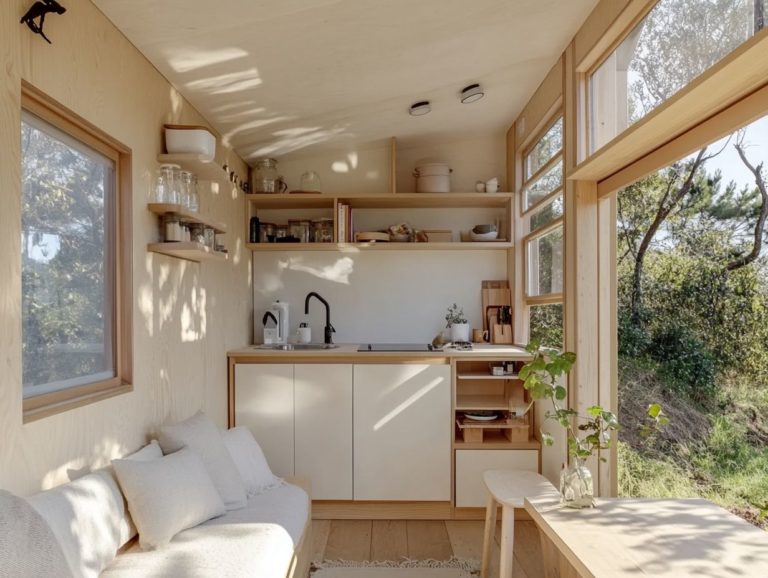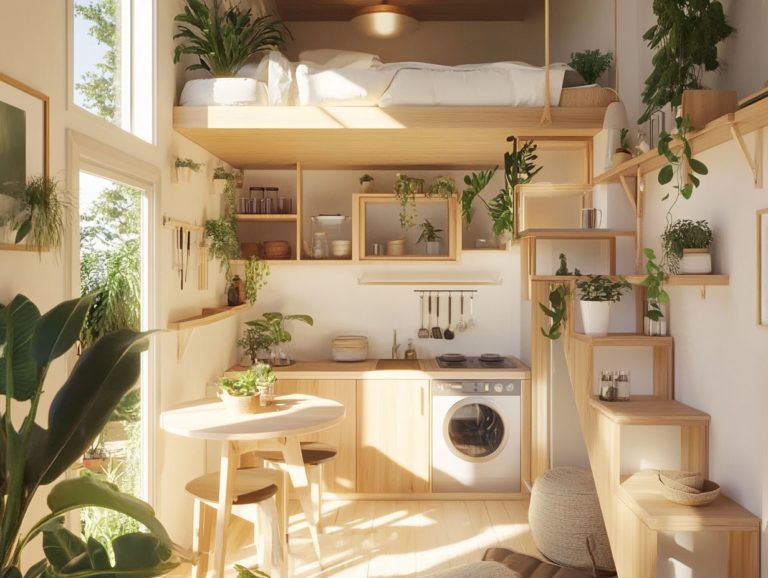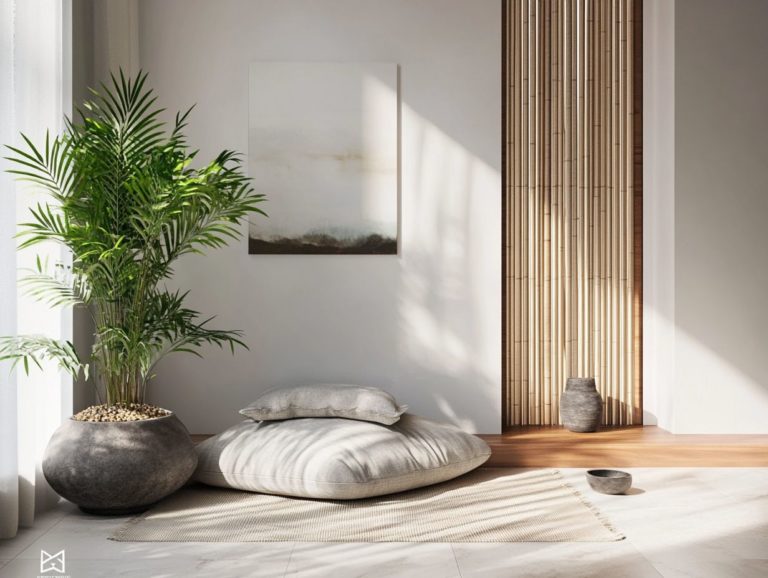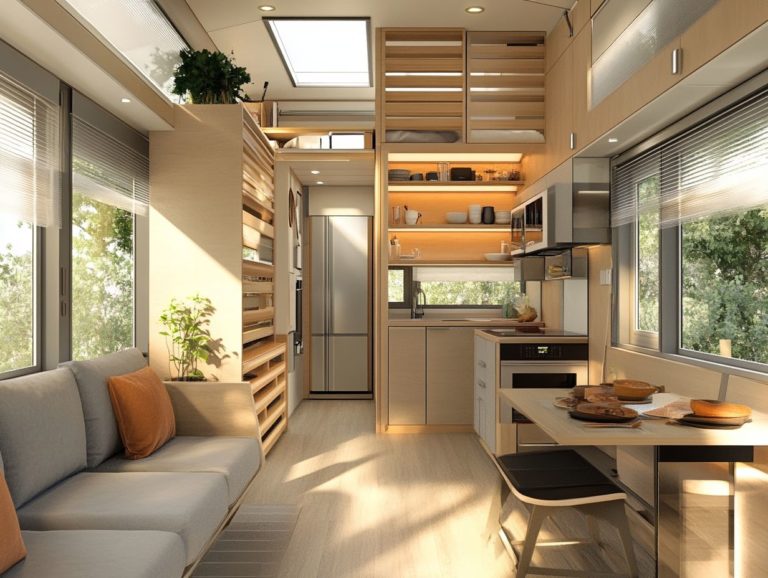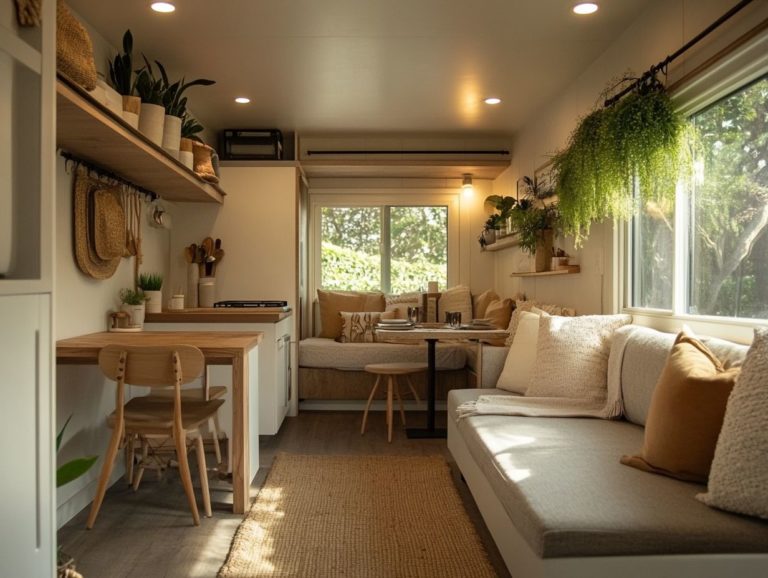How to Integrate Technology in Tiny House Design
Tiny houses have undoubtedly captured your imagination. They present a minimalist lifestyle that emphasizes efficiency and sustainability.
The incorporation of technology in tiny house design elevates this concept even further. With features like solar panels and smart home systems, the right technology enhances your convenience while minimizing your environmental footprint.
In this article, you’ll discover exciting benefits, challenges, and innovative solutions for adding technology to tiny houses. This guide will help you optimize your limited space while fully embracing the essence of modern living.
Contents [hide]
- Key Takeaways:
- Benefits of Integrating Technology in Tiny House Design
- Examples of Technology Used in Tiny House Design
- Challenges and Considerations
- Tips for Integrating Technology in Tiny House Design
- Frequently Asked Questions
- What types of technology can be integrated into tiny house design?
- How can technology improve the functionality of a tiny house?
- What are the benefits of using renewable energy technology in tiny house design?
- How can I incorporate technology without sacrificing the minimalist aesthetic of a tiny house?
- What are some common challenges when integrating technology into tiny house design?
- Are there any resources available for learning how to integrate technology into tiny house design?
Key Takeaways:

- Integrating technology into tiny house design increases efficiency and convenience, making the most of limited space.
- Using technology in tiny house design reduces environmental impact and promotes sustainability.
- When adding technology to tiny houses, consider cost, maintenance, and compatibility with traditional building codes.
What is a Tiny House?
A tiny house is your compact sanctuary. Typically ranging from 100 to 400 square feet, these homes maximize every inch while championing sustainable living through innovative design and multi-functional furniture.
This minimalist lifestyle invites you to embrace eco-friendly practices, such as repurposing architectural salvage materials. You can craft homes that are not only cozy but also functional and aesthetically pleasing.
Tiny houses often come equipped with advanced home technology to enhance energy efficiency. Features like solar panels and smart thermostats help you minimize your environmental impact.
You’ll find popular designs incorporating lofted sleeping areas and foldable furniture, ensuring that limited space is utilized to its fullest while maintaining comfort and usability.
These compact homes resonate with the burgeoning movement towards sustainable living. They appeal to those who crave fewer possessions and richer experiences.
By emphasizing community and simplicity, tiny houses foster a warm atmosphere. This encourages you to lead a more intentional lifestyle that s beautifully in tune with the environment around you.
The Role of Technology in Design
Technology plays a pivotal role in enhancing the functionality and comfort of tiny houses. It seamlessly integrates modern amenities that cater to your needs while embracing the latest trends in smart home technology.
Imagine voice-controlled smart lighting and smart thermostats harmonizing within your compact space. The design of tiny houses is evolving, prioritizing energy efficiency and convenience like never before.
These innovations simplify your daily tasks and contribute significantly to energy conservation. Tiny living becomes a truly sustainable choice.
For instance, smart refrigerators that monitor your food inventory can help reduce waste. Meanwhile, automated blinds adjust based on the time of day, optimizing natural light and minimizing energy use.
You might even consider smart irrigation systems for your minimal outdoor space. This ensures that water is used efficiently.
All these elements come together to create a living environment that is comfortable, stylish, and environmentally responsible. This makes the tiny house movement appealing for discerning homeowners.
Benefits of Integrating Technology in Tiny House Design
Integrating technology into your tiny house design offers a wealth of benefits. It particularly enhances efficiency and convenience.
This approach transforms compact living spaces into functional and enjoyable environments tailored to your lifestyle.
By embracing innovative solutions like smart home systems, energy-efficient appliances, and automated features you can significantly elevate your daily living experience.
Each thoughtful integration not only maximizes space but also enriches your quality of life in ways you may not have imagined.
Efficiency and Convenience
By incorporating energy-efficient smart appliances and home automation technologies, tiny houses elevate your living experience to a new level of efficiency and convenience. These advancements streamline daily tasks and save energy, making tiny homes both eco-friendly and practical.
Smart locks enhance security by letting you access your space remotely, offering you peace of mind and eliminating the hassle of carrying physical keys. Smart blinds allow you to program adjustments based on the time of day, maximizing natural light while reducing heating or cooling needs.
Automated systems adapt to your routines and effectively manage energy consumption, contributing to both comfort and sustainability. By integrating these cutting-edge technologies, tiny homes redefine efficient living, making them a compelling choice for anyone pursuing smart design solutions for tiny house living and a modern, responsible lifestyle.
Reduced Environmental Impact
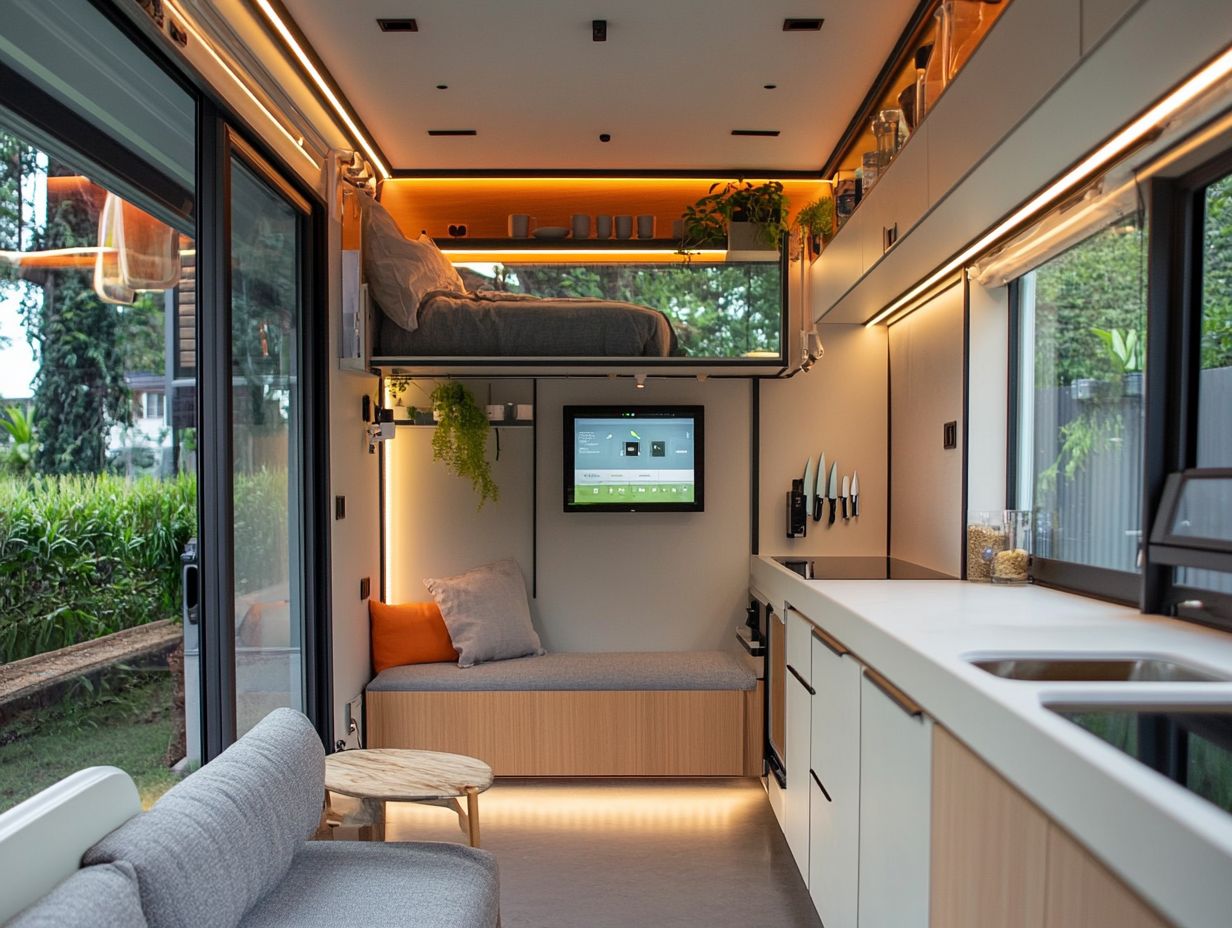
Implementing technology in your tiny house design significantly reduces your environmental impact. This promotes a sustainable lifestyle through eco-friendly practices like rainwater collection and solar panel usage. Such practices minimize your carbon footprint and support energy conservation, making your compact home a model of environmental responsibility.
With smart home systems, you can monitor and manage your energy usage in real time, optimizing efficiency further. Utilizing innovative insulation materials and energy-efficient appliances dramatically cuts electricity consumption, reducing reliance on fossil fuels.
Sustainable waste management solutions, such as composting toilets and greywater recycling, ensure that even daily living byproducts are managed sustainably. Together, these advancements create a comfortable living environment and encourage you to embrace a lifestyle centered around sustainability.
Examples of Technology Used in Tiny House Design
You can employ various technologies in tiny house design to optimize space and enhance functionality:
- Solar panels
- Smart home systems
- Innovative space-saving furniture solutions
These elements boost energy efficiency and maximize your limited square footage, allowing you to enjoy modern conveniences without compromising comfort.
Solar Panels and Renewable Energy
Incorporating solar panels into your tiny house design is a brilliant way to harness renewable energy. This significantly boosts your energy efficiency while championing sustainable living practices. By generating your electricity, you reduce reliance on traditional power sources and diminish your environmental impact.
This transition leads to savings on your electricity bills and nurtures a sense of energy independence. In the realm of tiny homes, where minimalism reigns, every inch counts; utilizing solar power enables a decluttered lifestyle while reducing your carbon footprint.
As more individuals embrace tiny house living, the significance of solar panels grows, playing a crucial role in our collective commitment to a greener future. Ultimately, adopting renewable energy sources brings financial relief and supports the larger mission of environmental stewardship.
Consider exploring tiny house living and renewable energy options to enjoy the benefits of a sustainable lifestyle today!
Smart Home Systems
Smart home systems transform tiny house living by integrating technology into an easy automation system. You can control everything from lighting to appliances, making your living experience much more convenient and secure.
With smart sensors and connected devices, monitoring energy use becomes simple. This helps you adopt sustainable living practices while providing customizable alerts and remote monitoring for safety threats like smoke or surveillance cameras.
Advanced technologies allow devices to communicate seamlessly. Create tailored routines that simplify everyday tasks and enjoy a stress-free environment.
Space-Saving Furniture and Storage Solutions
In tiny house design, using space-saving furniture and clever storage solutions is key. This helps you enjoy comfort and functionality in small spaces.
Consider items like fold-out tables and sofa beds; these can transform your area into a spacious and inviting home. A convertible coffee table can become a dining area for guests without cluttering your space.
Vertical storage, like tall bookcases, utilizes overlooked spaces and creates a sense of openness. Thoughtful planning ensures your tiny home is both practical and visually appealing.
Challenges and Considerations
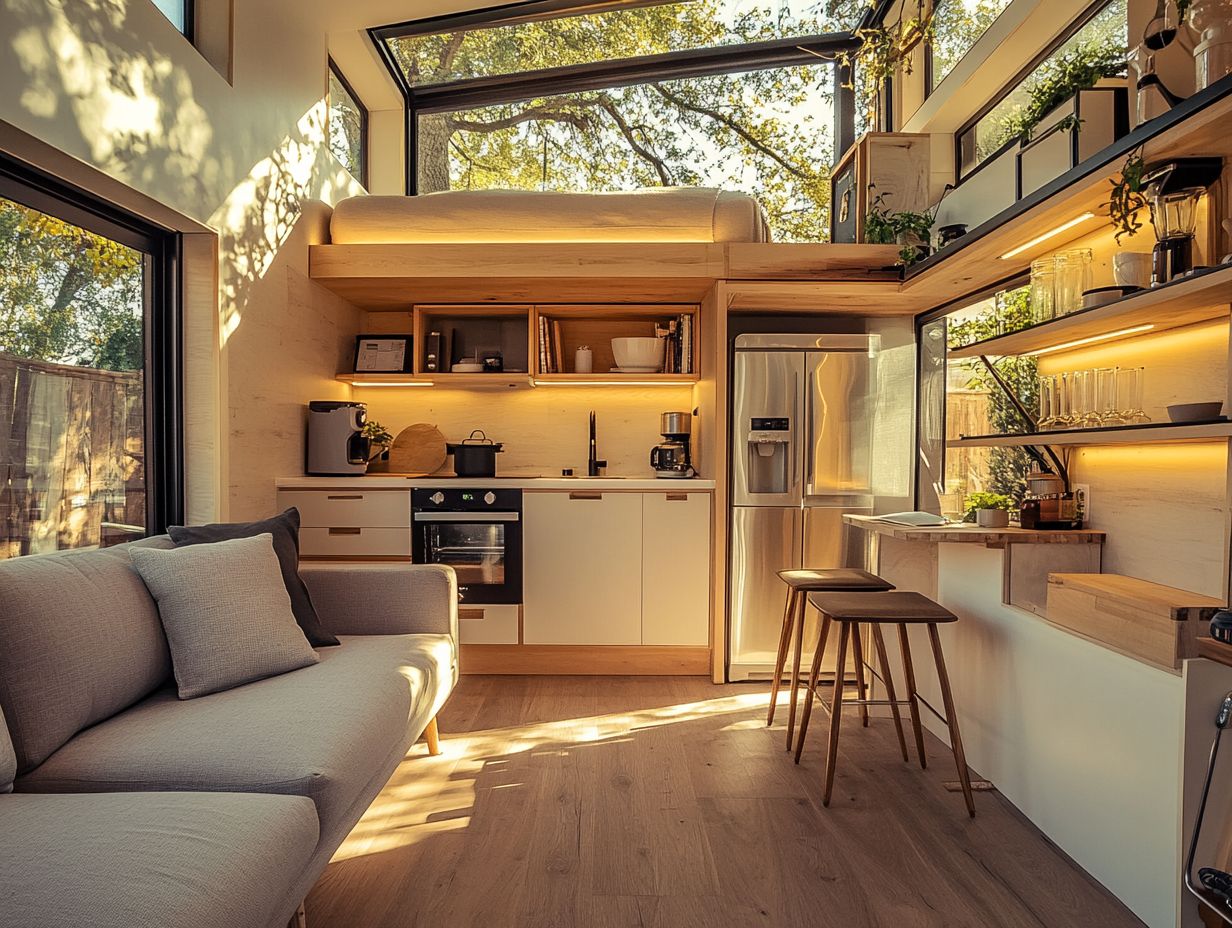
Integrating technology into tiny house design offers many benefits but comes with challenges, especially regarding cost and maintenance.
Understanding how your chosen technologies fit with building rules is crucial for your tiny house project.
Cost and Maintenance
The cost of adding technology can vary significantly based on the systems you choose and their maintenance. You must budget carefully for both initial investment and long-term upkeep to keep your home efficient.
This financial planning is vital; even minor expenses can add up. While smart home devices might seem pricey upfront, they can lead to lower energy bills over time. Integrating renewable energy sources like solar panels may initially cost more but can greatly reduce future expenses.
Ultimately, finding the right balance between immediate costs and future savings empowers you to make informed decisions that fit your lifestyle.
Compatibility with Traditional Building Codes
Ensuring compatibility with traditional building codes is a critical consideration for your tiny house design. This is especially important as you integrate advanced technology solutions. You ll need to navigate various regulations to ensure your tiny home aligns with local laws while embracing innovative design options.
Understanding these regulations is vital for fully leveraging the benefits of advanced technologies like solar panels and energy-efficient appliances. Compliance helps you avoid significant fines and construction interruptions. It also guarantees the safety and sustainability of your living environment.
Key regulations often address aspects like electrical systems, plumbing, insulation, and structural integrity. All of these can greatly influence how you implement technology in your tiny home. For those looking to modernize their space, incorporating smart home technology in tiny houses can be a great solution. Familiarizing yourself with these codes empowers you to enhance your living experience without compromising on legality or comfort.
Tips for Integrating Technology in Tiny House Design
Successfully integrating technology into your tiny house design requires meticulous planning and thorough research. Each element should enhance your living experience without cluttering the compact space.
It s wise to collaborate with professionals who specialize in smart home systems and sustainable architecture. This ensures you achieve the best possible results tailored to your unique lifestyle.
Research and Planning
Thorough research and meticulous planning are essential when integrating technology into your tiny house design. This ensures every decision aligns perfectly with your overall vision for your home. Take time to evaluate your needs and preferences while exploring available technologies that can enhance your living space.
This process requires a sharp focus on factors like your lifestyle choices and budget constraints. For example, understanding your daily energy consumption will guide your decisions about solar panel installations or energy-efficient appliances. Similarly, assessing your lifestyle can lead to smarter choices regarding connectivity options or automation systems.
Ultimately, dedicating time to grasp these elements will help you optimize technology integration. This transforms your tiny house into not just a functional space, but a true reflection of your vision and values, especially when incorporating sustainable design practices for tiny houses.
Working with a Professional
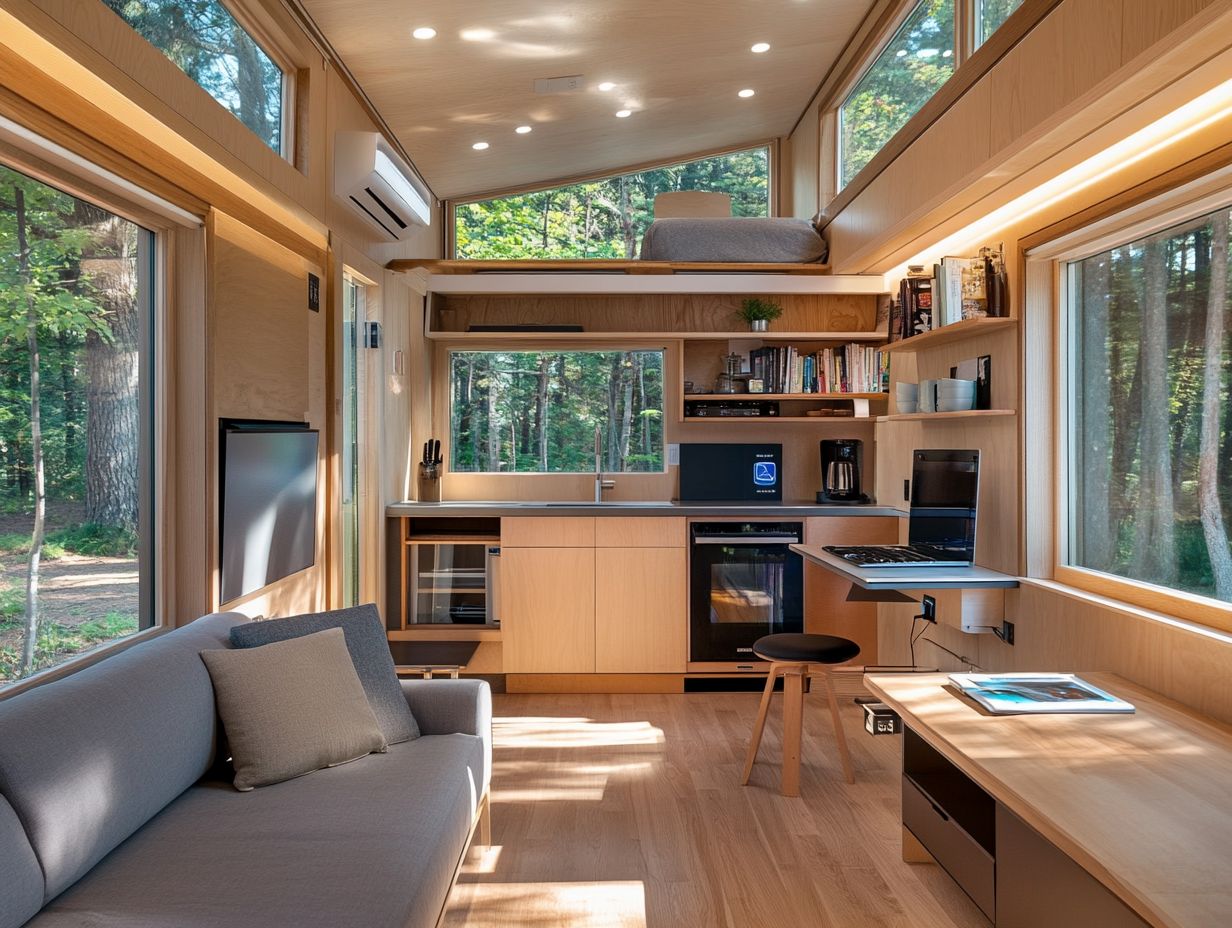
Working with the right experts can supercharge your tiny house project! Professionals who specialize in tiny house design and technology integration offer invaluable insights and expertise. They help homeowners navigate the intricate world of technology, ensuring your tiny house is functional and compliant with all relevant building codes.
By tapping into their knowledge, you gain access to customized solutions that resonate with your unique needs and preferences. Their expert advice streamlines the design process and assists you in selecting sustainable materials and innovative energy solutions, making your tiny home both efficient and environmentally friendly. Additionally, consider incorporating nature into tiny house designs for a harmonious living space.
These professionals stay updated on the latest trends and regulations in the industry. This ensures every facet of your project aligns with current best practices. Ultimately, their guidance can transform your tiny house experience into one that is more personalized, effective, and successful.
Frequently Asked Questions
Here are answers to some common questions about integrating technology into tiny house designs.
What types of technology can be integrated into tiny house design?
There are various types of technology that can be incorporated into tiny house design, such as smart home systems, energy-efficient appliances, and solar panels.
How can technology improve the functionality of a tiny house?
By integrating technology, tiny houses can be more efficient and convenient. For example, smart home systems let you automate tasks like adjusting the temperature or turning off lights, saving time and energy.
What are the benefits of using renewable energy technology in tiny house design?
Using energy from sources that don t run out, like the sun or wind, can cut your reliance on traditional energy sources. This makes tiny houses more eco-friendly and saves you money in the long run.
How can I incorporate technology without sacrificing the minimalist aesthetic of a tiny house?
Many compact technology options can blend seamlessly into tiny house designs. Consider using wireless speakers, hidden outlets, and slim smart home devices.
What are some common challenges when integrating technology into tiny house design?
Space limitations and budget constraints can pose challenges. Carefully plan which technologies are essential for your tiny house.
Are there any resources available for learning how to integrate technology into tiny house design?
Yes! You can find many online tutorials, forums, and workshops focused on technology in tiny house design. Consulting with industry professionals can also provide valuable insights.


